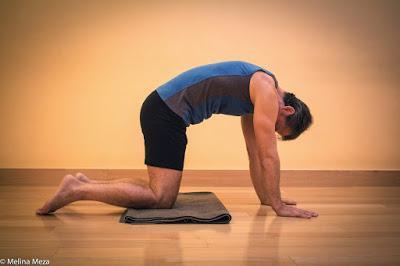 Cat-Cow pose is a dynamic pose that gently warms up your spine, preparing you for almost any type of yoga practice. For some people, these gentle movements can relieve low back pain. Because you’re bearing weight on your hands, knees, and shins, this pose strengthens your arms and shoulders. It can help strengthen your many of your bones, including your spine and wrists. Because you connect your movements with your breath, practicing Cat-Cow allows you to cultivate awareness of the present moment awareness and improves breathing capacity. The chair version makes the pose accessible to everyone.
Cat-Cow pose is a dynamic pose that gently warms up your spine, preparing you for almost any type of yoga practice. For some people, these gentle movements can relieve low back pain. Because you’re bearing weight on your hands, knees, and shins, this pose strengthens your arms and shoulders. It can help strengthen your many of your bones, including your spine and wrists. Because you connect your movements with your breath, practicing Cat-Cow allows you to cultivate awareness of the present moment awareness and improves breathing capacity. The chair version makes the pose accessible to everyone.Baxter prescribes it for:
- warming up for a yoga practice or for other physical activities, such as running, biking, swimming, and gardening.
- low back pain
- upper body weakness
- osteoporosis and osteopenia
- arthritis or stiffness of the hips and spine
- beginner’s experience of pranayama and improving breath capacity
- stress relief
- depression, lethargy, or times when you just don’t feel like practicing
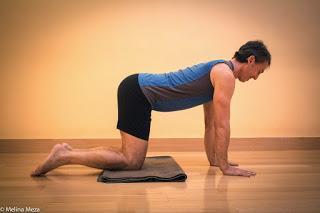 This neutral hands and knees position is the pose you take before beginning your dynamic movements in and out of Cow and Cat. It’s also the pose you return to after you’ve completed all your rounds and are ready to come out of the pose. To set up for the pose, place a folded blanket cross-wise in the middle of your mat to cushion your knees. Then come into a hands and knees position, with your knees on the blanket and your hands on the mat. Align your hips directly over your knees and your shoulders directly above your wrists. Now, evenly spread your palms and fingers, and press your hands into the floor. To keep your arms straight, firm the muscles around your elbows. While keeping it parallel with the floor, lengthen your spine from your tailbone to the crown of your head.To come out of the pose, after completing a set of of dynamic Cat/Cow, simply sit back on your heels.2. Cow
This neutral hands and knees position is the pose you take before beginning your dynamic movements in and out of Cow and Cat. It’s also the pose you return to after you’ve completed all your rounds and are ready to come out of the pose. To set up for the pose, place a folded blanket cross-wise in the middle of your mat to cushion your knees. Then come into a hands and knees position, with your knees on the blanket and your hands on the mat. Align your hips directly over your knees and your shoulders directly above your wrists. Now, evenly spread your palms and fingers, and press your hands into the floor. To keep your arms straight, firm the muscles around your elbows. While keeping it parallel with the floor, lengthen your spine from your tailbone to the crown of your head.To come out of the pose, after completing a set of of dynamic Cat/Cow, simply sit back on your heels.2. Cow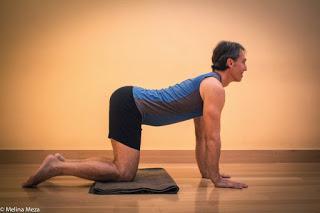 This is the first position in the dynamic sequence of Cat-Cow. It takes your spine into a backbend, strengthening your back spinal muscles, while stretching the front of your belly and chest, and encouraging a full inhalation. To come into the pose, as you start your inhalation, gradually arch your spine into a backbend shape. Start by moving from your pelvis, lifting your tailbone and sitting bones up as your pelvis tips forward over your leg bones, relaxing your belly and lower back down, and lifting your chest and head forward. Keep your chest lifted and your collarbones broad as you continue pressing your hands into the floor and firming the muscles around your elbows.As you move, focus your attention on the smoothness of your breath and sensations that arise. When you’re ready to exhale, you’ll move into Cat pose.3. Cat
This is the first position in the dynamic sequence of Cat-Cow. It takes your spine into a backbend, strengthening your back spinal muscles, while stretching the front of your belly and chest, and encouraging a full inhalation. To come into the pose, as you start your inhalation, gradually arch your spine into a backbend shape. Start by moving from your pelvis, lifting your tailbone and sitting bones up as your pelvis tips forward over your leg bones, relaxing your belly and lower back down, and lifting your chest and head forward. Keep your chest lifted and your collarbones broad as you continue pressing your hands into the floor and firming the muscles around your elbows.As you move, focus your attention on the smoothness of your breath and sensations that arise. When you’re ready to exhale, you’ll move into Cat pose.3. Cat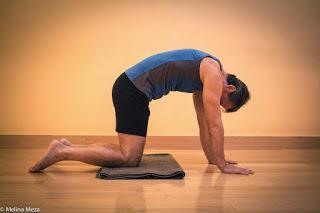 This is the second position in the dynamic sequence of Cat-Cow. It takes your spine into a forward rounding position, which strengthens your abdominal and front chest muscles, while stretching your back muscles and encouraging a long exhalation. To come into the pose, as you start your exhalation, gradually round your spine toward the ceiling, Start by moving from your pelvis, turning your tailbone and sitting bones down as your pelvis tips backwards, hollowing your belly towards your spine, and releasing your neck and head toward the floor and looking back to your knees. Keep your neck relaxed as you continue pressing your hands into the floor and firming the muscles around your elbows. As you move, focus your attention on the smoothness of your breath and sensations that arise. When you’re ready to inhale, you’ll move back into Cow pose. If you’ve finished your final round, inhale and return to the starting position instead.4. Seated on a Chair
This is the second position in the dynamic sequence of Cat-Cow. It takes your spine into a forward rounding position, which strengthens your abdominal and front chest muscles, while stretching your back muscles and encouraging a long exhalation. To come into the pose, as you start your exhalation, gradually round your spine toward the ceiling, Start by moving from your pelvis, turning your tailbone and sitting bones down as your pelvis tips backwards, hollowing your belly towards your spine, and releasing your neck and head toward the floor and looking back to your knees. Keep your neck relaxed as you continue pressing your hands into the floor and firming the muscles around your elbows. As you move, focus your attention on the smoothness of your breath and sensations that arise. When you’re ready to inhale, you’ll move back into Cow pose. If you’ve finished your final round, inhale and return to the starting position instead.4. Seated on a Chair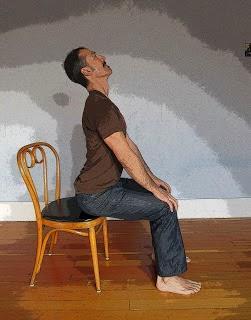 This version allows anyone who cannot bear weight on their arms or get down onto the floor to do similar spinal movements as the classic pose. It’s also an excellent office/traveling pose because you can do it sitting on most chairs.To set up for the pose, find a chair with a firm seat. Then sit near the front edge of the chair, with both your feet on the ground, your thighs parallel to each other, and your knees directly over your heels. Straighten your arms and rest your hands on your thighs or knees. Create an inner lift of your spine from your sitting bones to the crown of your head. To come into the Cow position, as you start your inhalation, gradually rock your pelvis forward, and lift and arch your spine into a gentle back bend. Allow your chest to move forward and up and lift your chin a few inches. To come into the Cat position, as you start your exhalation, gradually rock the pelvis back and round your spine gently towards the back of your chair. Drop your chin a few inches toward your chest. As you move in and out of the two positions, focus your attention on the smoothness of your breath and sensations that arise. When you’ve finished your final round, return to your starting position before moving on. Subscribe to Yoga for Healthy Aging by Email ° Follow Yoga for Healthy Aging on Facebook ° Join this site with Google Friend Connect
This version allows anyone who cannot bear weight on their arms or get down onto the floor to do similar spinal movements as the classic pose. It’s also an excellent office/traveling pose because you can do it sitting on most chairs.To set up for the pose, find a chair with a firm seat. Then sit near the front edge of the chair, with both your feet on the ground, your thighs parallel to each other, and your knees directly over your heels. Straighten your arms and rest your hands on your thighs or knees. Create an inner lift of your spine from your sitting bones to the crown of your head. To come into the Cow position, as you start your inhalation, gradually rock your pelvis forward, and lift and arch your spine into a gentle back bend. Allow your chest to move forward and up and lift your chin a few inches. To come into the Cat position, as you start your exhalation, gradually rock the pelvis back and round your spine gently towards the back of your chair. Drop your chin a few inches toward your chest. As you move in and out of the two positions, focus your attention on the smoothness of your breath and sensations that arise. When you’ve finished your final round, return to your starting position before moving on. Subscribe to Yoga for Healthy Aging by Email ° Follow Yoga for Healthy Aging on Facebook ° Join this site with Google Friend Connect

